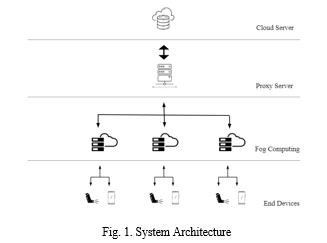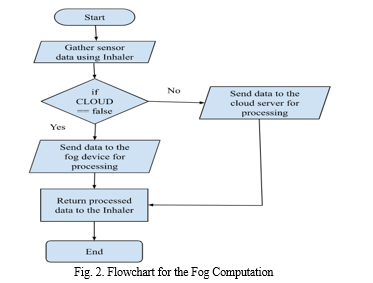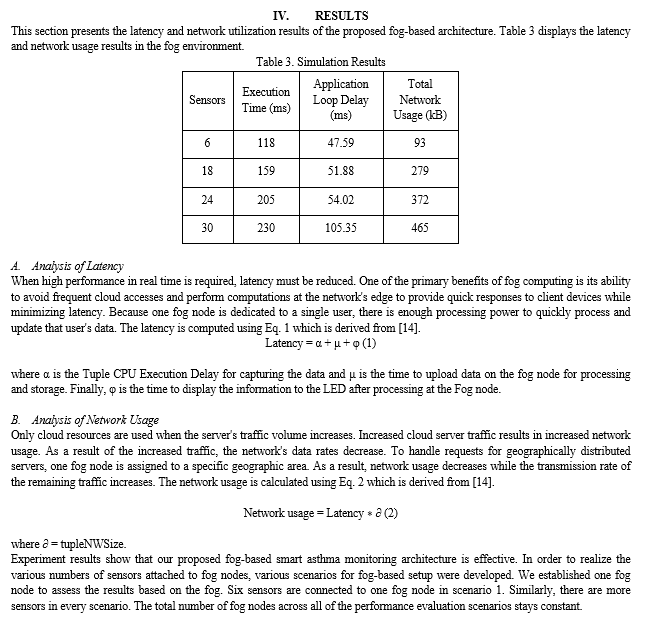Ijraset Journal For Research in Applied Science and Engineering Technology
- Home / Ijraset
- On This Page
- Abstract
- Introduction
- Conclusion
- References
- Copyright
Fog-Enabled Efficient Asthma Monitoring System
Authors: Vaishnavi Kadam, Soham Raorane, Chirag Dodia, Apurva Shardul
DOI Link: https://doi.org/10.22214/ijraset.2023.51407
Certificate: View Certificate
Abstract
For monitoring patients at risk for chronic diseases, wireless and wearable sensors are now widely used in the healthcare sector. This guarantees that patients adhere to their treatment regimens and safeguards them from unexpected attacks. Numerous sensors have produced a vast amount of data. In this paper, we propose to use fog computing to support the monitoring of asthma patients using IoT-enabled devices such as smart inhalers to monitor the rate and environmental factors surrounding asthma attacks, ensuring that data is collected and processed effectively. The main challenge would be limiting the selection of information to that which is pertinent to the patient\'s health in the given context. A fog computing layer is necessary because a simple sensor-to-cloud architecture is unworkable. By minimizing the amount of data transferred back and forth between the cloud and the sensors and removing the risk that a data center failure carries, this increases overall system efficiency.
Introduction
I. INTRODUCTION
Asthma is a chronic condition that is extremely burdensome for many people. It is a respiratory condition that affects both the lungs and the rest of the respiratory system. According to estimates, this global health issue affects 300 million people. Asthma risk factors are complex interactions of inherited and environmental factors.
The goal of asthma treatment is to improve overall lung function, reduce daily symptoms, and prevent severe asthma attacks. Every patient receives an individualized treatment and disease self-management plan designed to alleviate daily symptoms, maintain optimal lung function, and allow participation in daily activities while reducing the frequency of acute asthma attacks. Acute asthma attacks frequently occur unexpectedly, making it difficult to predict when they will occur i.e., suddenly and without warning.
The severity level of an asthma attack is even more difficult to predict because it is determined by a number of factors, including the individual's disease characteristics and severity, how well the disease is managed with medications, and the trigger of the asthma attack. A system that can detect diseases in real time is becoming more common. The use of wireless sensor networks (WSN) has greatly improved the way patients are monitored in healthcare applications.
Wireless sensors, in the form of wireless wearable accessories or devices, are attached to patients to collect data that can be used in the monitoring process. Continuous patient monitoring, real-time illness detection, lowering the need for and cost of hospitalization, utilizing technologies, emergency medical assistance, and finally obtaining more accurate data are all advantages of IoT-based health monitoring systems.
A. Case Study
The recent success of low-power wearable systems for tracking environmental and health data for monitoring and managing chronic respiratory illness prompted the development of an artificial intelligence algorithm that performs adaptive learning for personalized prediction and treatment plans. The most widely available form of technology on the planet, smart phones, provide a very practical system for self-monitoring as well as immediate feedback, potentially involving the patient in the monitoring and management of their asthma. Mobile apps enable technology to advance human health while preserving the critical doctor-patient relationship. Many healthcare professionals believe that virtual healthcare delivery can assist patients in managing chronic conditions on a daily basis.
Non-adherence is one of several factors that contribute to ineffective asthma monitoring. As a result, novel solutions to simplify monitoring and maintain stable asthma control are urgently needed. As a result, smart inhalers are laying the groundwork for the development of better treatments. As a result, the price and interest in medical electronic devices have risen significantly in recent years.
Smart inhalers help people with asthma regularly track the frequency and environmental factors influencing their asthma attacks and serve as a gentle reminder to take their medications. These are the gadgets that are connected to the mobile phone application. They enable following all significant information, such as the dosage schedule or usage conditions. The sensor is attached to the inhaler and uses Bluetooth to connect with the program. Every time a drug is used, data is also recorded, including details about the drug's uses, a specific location and time, and environmental information. By gathering data, these mobile devices are purposefully made to help with treatment plan adherence. In the near future, they might be applied to forecast asthma attacks and monitor treatment progress.
While continuous offloading tasks can provide high-quality real-time services to end users, continuous sensing and data transmission over the network can significantly reduce battery life. A monitoring system must be aware of its context and internal state in order to adaptively adjust its sensing energy and accuracy at run-time when a power-saving opportunity presents itself. By sensing environmental parameters and their state (e.g., active or inactive) and acting appropriately as needed, self-aware monitoring systems can make wise decisions on the fly, such as battery life or user pain level. They frequently use the Observe, Decide, and Act (ODA) control loop paradigm to dynamically control the system based on real-time observations.
II. RELATED WORK
In this section, the research already done in this area will be reviewed.
- Wudan et al. [1] talks about better management of asthma using various wearable devices monitoring a patient, smart and connected inhalers through an app, the biologics behind the drug delivery of the inhaler, and how to improve aerosol drug delivery into the lungs.
- Martin S. Holmes et al. [2] studied the need for patients’ adherence to their asthma medication regime. Manually listening to inhaler use recordings is a time-consuming and labor-intensive process, so an algorithm that can do this task automatically and accurately would be extremely beneficial. In this study, the acoustic signals of patients taking their prescribed medication are recorded using a recording device attached to a common dry powder inhaler.
- James Dieffenderfer et al. [3] evaluated Low Power Wearable Systems efficiency for Continuous Monitoring of the Environment and Health for Chronic Respiratory Disease. They presented preliminary results demonstrating the wearability and functionality of each of the sensor subsystems discussed, as well as the power consumption. The proof of concept is restricted to each sensor's ability to generate reasonable preliminary output in controlled environments.
- Kaseem et al. [4] developed asthma care apps for better management of asthma patients. His work was to develop a telemedicine system that can manage asthma data for patients in childhood without the need for frequent visits to health care centers. The system included the development of a multi-functional device that can solve the problem of daily patient monitoring.
III. PROPOSED SYSTEM
Figure 1 shows the three layers that make up the proposed architecture. The patient's data must be collected and analyzed using the smart inhaler, which is the first layer and has numerous sensors. A microcontroller connects the sensors to a fog node, which is part of the second layer of the system. The third layer consists of a cloud connected to the fog and in charge of long-term data storage and management.

A. Sensors and Microcontroller
Sensors and microcontrollers are Tier 1 components of the intelligent asthma monitoring system. The primary goal of this research is to compare the network usage of fog servers with changes in the average number of sensors per fog node. Sensors connected to the microcontroller collect data. The sensors in the proposed framework operate on 1-5.5 Volts, as shown in Table 1. The microcontroller is programmed to send the user's captured data to the fog node for further processing.
|
Sensor |
Power (Volts) |
|
MAX30100 (Pulse Oximeter and Heart Rate Monitor) |
3.3 |
|
MLX90614 (Infrared Thermometer) |
3.3 |
|
DHT11 (Temperature and Humidity Sensor) |
5.5 |
|
MQ-135 (Gas Sensor) |
5 |
|
AD8232 (ECG Sensor) |
5 |
Table 1. Power usage of each sensor
After all of the sensors have been initialized, the user's data is collected. Following the data acquisition phase, the collected data is processed in the fog node. The user receives the processed data. The following are the steps for the entire framework:
- Start
- Initialize the system
- Set a fog device
- Set sensor transmission time
- Data acquisition
- Collect data from the user via the sensors
- Send data to the fog node for processing
- Return processed data to the user
- End
B. Fog Node
It is the layer between the sensors and the cloud that collects data from the sensors with the microcontroller in order to further determine the user's asthma symptoms and overall health. The status of the user is constantly updated by the fog. The fog node temporarily holds the data before sending it to the cloud. The fog computing infrastructure is activated as a supporting middle layer between edge nodes and the cloud to collect, process, and analyze the data at the edge in order to process the real-time data of the user's condition.
C. Cloud Layer
When the fog node no longer requires the data, the cloud in the proposed framework stores it in its storage. An intermediary server allows for communication between the cloud and the fog. After a predetermined amount of time, the fog node sends the data to the cloud, which then provides the data the fog needs.

The interoperability of fog computing is one of its many distinguishing features, and it is critical when considering the diversity of edge nodes that lie beneath. To meet the storage and computation needs of the surrounding fog nodes, fog nodes extricate some resources in order to collaborate. In our hypothetical scenario, we assume that fog nodes can communicate with one another via a proxy server and share critical information. Because interoperability is an inherent property, we will not consider latency for fog node communication.
D. Experimental Setup
We created a model of a situation in which the fog node receives data from the sensors after it has been collected. The user is provided with the processed data by the fog node after it has determined the user's condition. The connection between the cloud server and the fog node(s) is made by a proxy server. We used iFogSim, a toolkit for IoT devices, to model the scenarios. We can assess the latency and network usage using the iFogSim.
|
Parameter |
Cloud |
Proxy |
Fog |
|
CPU Length (MIPS) |
44800 |
2800 |
2800 |
|
RAM (MB) |
40000 |
40000 |
40000 |
|
Uplink Bandwidth (MB) |
100 |
10000 |
10000 |
|
Downlink Bandwidth (MB) |
10000 |
10000 |
10000 |
|
Level |
0 |
1 |
2 |
|
RatePerMIPS |
0.01 |
0.0 |
0.0 |
|
Busy Power (Watt) |
16*103 |
107.339 |
107.339 |
|
Idle Power (Watt) |
16*83.25 |
83.43 |
83.43 |
Table 2. Parameter values of Fog, Proxy and Cloud for Fog-based scenario
For the simulation, we made the scenario's variables and a variety of sensors. Four sensors were initially assigned to each user in order to collect data through sensors. Our fog nodes are connected to a primary cloud device that we built using a proxy server. It is important to note that we made one fog node for each area. Considering that a microcontroller connects the sensors. We increased the sensor count to evaluate the outcomes for various scenarios.

Conclusion
The Asthma Monitoring System aims to make asthmatic patients\' lifestyles better. Through the creation of individualized smart asthma monitoring, this paper illustrated our vision for how life can be made better for those who suffer from the condition. The depiction is based on the samples of collected data and their analysis. With the help of the Internet of Things, readily available data, and tailored feedback, we hope to make life easier for those who struggle with asthma. Fog computing has recently taken on a major role, especially in application domains where time is of the essence. The demand for quicker responses has grown in tandem with the proliferation of data-generating devices. To that end, we put forth a fog-based asthma monitoring system that makes use of a computer vision technique to quickly determine a user\'s condition intensity and overall condition, ultimately minimizing the amount of time required. According to the experimental findings, the suggested fog-based architecture not only minimizes latency but also uses less network bandwidth. We considered task offloading to more powerful layers in this paper because highly accurate asthma monitoring necessitates intensive computation on IoT and wearable devices. Offloading can enhance the quality of service at the Edge, but it is impractical to continuously collect data and send it to higher layers for long-term monitoring. In this paper, a self-aware system for long-term real-time pain monitoring is proposed.
References
[1] Wudan Yan,” Towards better management for asthma, Digital Object Identifier “10.1109/MPUL.2017.2772398, Date of publication: 24 January 2018. [2] Martin S. Holmes, Marine Le Menn, Shona D’Arcy, Viliam Rapcan, Elaine MacHale, Richard W. Costello and Richard B. Reilly, Senior Member, IEEE, “Automatic Identification and Accurate Temporal Detection of Inhalations in Asthma Inhaler Recordings”, 34th Annual International Conference of the IEEE EMBS San Diego, California USA, 28 August - 1 September 2012. [3] James Dieffenderfer, Henry Goodell, Steven Mills, Michael McKnight, Shanshan Yao, Feiyan Lin, Eric Beppler, Brinnae Bent, Bongmook Lee, Veena Misra, Yong Zhu, Omer Oralkan, Jason Strohmaier, John Muth, David Peden, and Alper Bozkurt, “Low Power Wearable Systems for Continuous Monitoring of Environment and Health for Chronic Respiratory Disease”: DOI 10.1109/JBHI.2016.2573286, IEEE Journal of Biomedical and Health Informatics. [4] A. Kassem, M. Hamad, C. El-Moucary, E. Neghawi, G. Bou Jaoude, and C. Merhej, “ Asthma Care Apps”, 2013 2nd International Conference on Advances in Biomedical Engineering. [5] S. Pallewatta, V. Kostakos, and R. Buyya, “Microservices-based IoT application placement within heterogeneous and resource-constrained fog computing environments,” in Proceedings of the 12th IEEE/ACM International Conference on Utility and Cloud Computing, 2019, pp. 71–81. [6] Belal Alshaqaqi, Abdullah Salem Baquhaizel, Mohamed El Amine Ouis, Meriem Boumehed, Abdelaziz Ouamri, and Mokhtar Keche, “DRIVER DROWSINESS DETECTION SYSTEM”, 2013 8th International Workshop on Systems, Signal Processing and their Applications (WoSSPA). [7] M. Goudarzi, H. Wu, M. Palaniswami, and R. Buyya, “An application placement technique for concurrent IoT applications in edge and fog computing environments,” IEEE Transactions on Mobile Computing, vol. 20, no. 4, pp. 1298–1311, 2020. [8] X. Xu, Q. Liu, Y. Luo, K. Peng, X. Zhang, S. Meng, and L. Qi, “A computation offloading method over big data for IoT-enabled cloud-edge computing,” Future Generation Computer Systems, vol. 95, pp. 522–533, 2019. [9] “Real-time facial landmark detection with OpenCV, Python, and dlib”, pyimagesearch, https://www.pyimagesearch.com/2017/04/17/real-time- facial-landmark-detection-opencv-python-dlib/. [10] Petchara Inthanon and Surasak Mungsing, “Detection of Drowsiness from Facial Images in Real-Time Video Media using Nvidia Jetson Nano”, 2020 17th International Conference on Electrical Engineering/Electronics, Computer, Telecommunications and Information Technology (ECTI-CON). [11] Manu B.N, “Facial Features Monitoring for Real Time Drowsiness Detection”, 2016 12th International Conference on Innovations in Information Technology (IIT). [12] Wisaroot Tipprasert, Theekapun Charoenpong, Chama- porn Chianrabutra and Chamaiporn Sukjamsri, “A Method of Driver’s Eyes Closure and Yawning Detection for Drowsiness Analysis by Infrared Camera”, 2019 First International Symposium on Instrumentation, Control, Artificial Intelligence, and Robotics (ICA-SYMP). [13] W. Deng and R. Wu, \"Real-Time Driver-Drowsiness Detection System Using Facial Features\", in IEEE Access, vol. 7, pp. 118727-118738, 2019, doi: 10.1109/ACCESS.2019.2936663. [14] H. Gupta, A. V. Dastjerdi, S. K. Ghosh, and R. Buyya, ‘‘iFogSim: A toolkit for modeling and simulation of resource management techniques in the Internet of Things, edge and fog computing environments,’’ Softw., Pract. Exper., vol. 47, no. 9, pp. 1275–1296, 2017.
Copyright
Copyright © 2023 Vaishnavi Kadam, Soham Raorane, Chirag Dodia, Apurva Shardul. This is an open access article distributed under the Creative Commons Attribution License, which permits unrestricted use, distribution, and reproduction in any medium, provided the original work is properly cited.

Download Paper
Paper Id : IJRASET51407
Publish Date : 2023-05-01
ISSN : 2321-9653
Publisher Name : IJRASET
DOI Link : Click Here
 Submit Paper Online
Submit Paper Online

